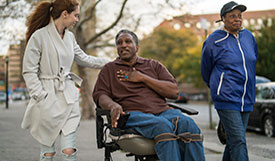Office of Research & Development |
 |
Office of Research & Development |
 |
March 21, 2019

Photo for illustrative purposes only. Photo: ©iStock/Alex Potemkin
Since the 1990s, a group of researchers at the Louis Stokes Cleveland VA Medical Center has studied how to restore respiratory function by stimulating the respiratory muscles in people with spinal cord injuries (SCIs). When the preliminary work with dogs showed that the approach was reasonable to try in people, many Veterans with SCIs were among the volunteers who participated in the clinical trials. Stimulators acting on the nerves that control the respiratory muscles, or directly on the diaphragm, have now replaced bulky mechanical ventilators and make more natural breathing possible for many patients with SCI.
The same researchers then continued their research with dogs to develop a way to stimulate the muscles in the pattern that produces an effective cough. Many people with SCI are at risk for potentially lethal respiratory infections and pneumonia because they cannot cough to clear their lungs and airways. The resulting cough stimulator was also tested with Veterans who volunteered for the clinical trials, and is now in use clinically, reducing the incidence of respiratory infections, improving quality of life, and dramatically reducing the costs of care for these people.
VA researchers continue to work on improving the cough stimulator technology. Advances could expand its use in Veterans with SCI, as well as in others who have difficulty coughing—for example, because of strokes or ALS.
Principal investigator: Krzysztof E Kowalski, Ph.D., Anthony DiMarco, M.D.; Louis Stokes Cleveland VA Medical Center
Research partners: MetroHealth Medical Center, Case Western Reserve University
Selected publications:
Bench to bedside: Researchers restore complete respiratory muscle function in subjects with SCI. Cleveland (OH): Cleveland FES Center; 2018 March 18.
Effects of expiratory muscle activation via high-frequency spinal cord stimulation. Kowalski KE, Romaniuk JR, Kowalski T, DiMarco AF. Appl Physiol. 2017 Dec 1;123(6):1525-1531.
High frequency spinal cord stimulation—New method to restore cough. Kowalski KE, Romaniuk JR, Brose SW, Richmond MA, Kowalski T, DiMarco AF. Respir Physiol Neurobiol. 2016 Oct;232:54-56.
High frequency spinal cord stimulation of inspiratory muscles in dogs: a new method of inspiratory muscle pacing. DiMarco AF, Kowalski KE. J Appl Physiol. 2009;107:662-669.
Spinal cord stimulation: a new method to produce cough in patients with spinal cord injury. DiMarco AF, Kowalski KE, Geertman RT, Hromyak DR. Am J Respir Crit Care Med. 2006;173:1386-1389.